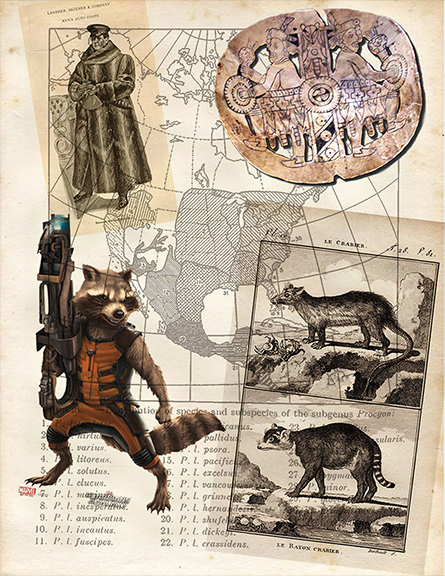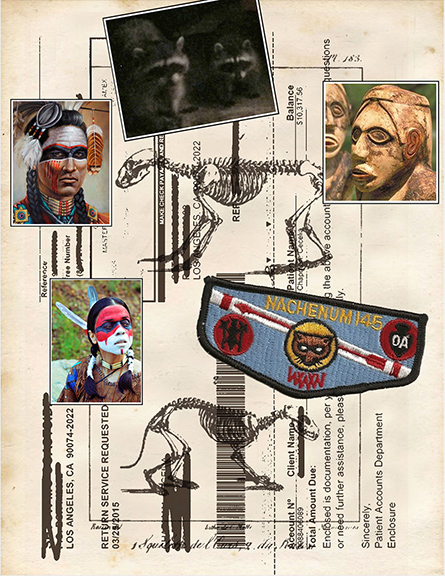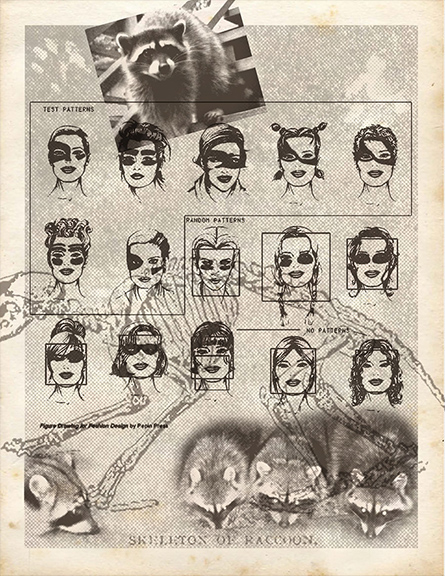

 My landlady told me her granddaughters found a raccoon in the spare bedroom that jumped through the window, leaving it's nest. The day before a trail of shredded chicken carcass, pieces of four bungee cords, trash, and chewed lid shards led me to my trashcan, rolled in the dry creek bed, two blocks from my apartment.
My landlady told me her granddaughters found a raccoon in the spare bedroom that jumped through the window, leaving it's nest. The day before a trail of shredded chicken carcass, pieces of four bungee cords, trash, and chewed lid shards led me to my trashcan, rolled in the dry creek bed, two blocks from my apartment.
"Raccoon," called "mapachtle" by the Aztec-Nahuatl, became "Apache" through the Spaniards. In 1598 Juan de Onate called the corn-stealing inter-Pueblo Athabascans "Apache." Onate named Western Apaches not only for their raids, but because they painted their eyes black, like a raccoon mask, similar to the later Jicarilla tribe at war with the U.S. Today "mapache" is a common word for "thief" in Mexico.
The raccoon was noted by members of the Christopher Columbus expedition and early North American historical writings as a "curious, unique and intelligent creature."
I first encountered a raccoon when a neighbor took in an injured one. The animal followed him everywhere like a dog until it grew old and died. He tried driving outside town and leaving the raccoon, but it always returned. It sat at the table or on the sofa and watched television with him with its little hands in its fat lap. Sometimes it would just suddenly roll onto the floor.
Originally, the Aztec glyph for the raccoon depicted its facile human-like "hands." The word "raccoon," derived from the Alqonquin Indian "arakun," and means "he scratches with his hands." Sioux Indians named the raccoon "wica" or "little man." The U.S. Whig Party were called "coons" when they used the raccoon as their party symbol, because they were seen as too sympathetic to African-Americans.
For two months I did not see the animal eating the food I left out every night. I began to whistle when I put the food down, and after a while the raccoon would lumber out like a little bear, from under the deck, or crawl down the handrail of the stairs. A few months later the raccoon would sit on the stairs waiting for me when I returned from work. After a while it would lay on its side on the stairs and stare in my glass door. Anything I left outside was examined and moved under the deck.
If the raccoon was not around a field rat appeared when I whistled. One night I whistled, left the food scraps, and closed the door because the raccoon had not appeared. A few seconds later I heard a horrible scream. When I looked out the raccoon was eating. I never saw the rat again.
The North American raccoon is a member of the family Procyonidae under the order of Carnivora, a placental mammal, Procyon lotor. All carnivores originally evolved as predators. About 135 million years ago in the Cretaceous period, insectivores were the earliest known placental mammals. They were small, tree dwelling, today's moles, hedgehogs, and shrews.
Everyone said (except a British friend, my manager at work, and my dog's veterinarian, who all fed raccoons), "It's against the law, raccoons are dirty, scary, aggressive, have diseases, and steal things..."
A sixth grade friend returned with her family from a three week camping trip to a gutted home. The sofas and beds had been shredded for nesting material, the cupboards stripped bare. Bed sheets, towels, pillows, clothing, rugs, a sixty pound bag of dog food, cans of food, had all been taken out the dog door where the raccoons had entered.
 One night I was outside smoking and put the cigarette down on the step when I saw the raccoon. When I returned with leftover food the raccoon was holding my cigarette watching the smoke. The raccoon was always interested in my different cameras. When I set a small one down on the door step to shoot video the raccoon knocked it over, jumping back in alarm. I showed the raccoon how to crack open peanut shells.
One night I was outside smoking and put the cigarette down on the step when I saw the raccoon. When I returned with leftover food the raccoon was holding my cigarette watching the smoke. The raccoon was always interested in my different cameras. When I set a small one down on the door step to shoot video the raccoon knocked it over, jumping back in alarm. I showed the raccoon how to crack open peanut shells.
Another warm evening I lay in bed watching the raccoon slowly pull the rug off my floor out the back door. The raccoon had pulled it completely out the door when I finally stood up and said, "No." The raccoon retreated under the deck.
The Apaches regard stealing as shameful only if one is caught.
In August I lay in bed with the back door open. The raccoon, who I had by then named Mapache, appeared and began to pace back and forth making chirping noises while wringing its hands, talking to me, watching me, for about half an hour.
Raccoons are thought to have over two hundred different sounds used for communication. (raccoon sounds: http://www.degus.com/racvidsound.html and http://www.soundboard.com/sb/Raccoon_Sounds_audio)
Mapache disappeared for about a week. One night I looked out to see it had returned. It had two friends, they were very small. They were Mapache's kits. My dog, who I trained not to chase them, threw up on the rug.
The kits were awkward, uncoordinated, made a lot of noise and fell all over the stairs. They were afraid of me. I was afraid my landlady would discover I was feeding raccoons. Mapache started growling at me, especially if I moved between her and the kits.
The raccoon's enemies are mostly nocturnal like themselves. Especially the young raccoons are easy prey to owl, hawk, bobcat, lynx, puma, coyote, fox, fishers, wolf, eagle, and large snakes. Humans are the raccoon's worst enemy though, through hunting, trapping, and cars.
During this time the daughter (in her mid-thirties, living in the downstairs apartment) of my next-door neighbor (away on a RV trip), took up with an alcoholic married man from down the street. They drank and fought, both loudly, every day, many times a day. Every morning they would argue and the daughter would throw him out. When she returned from work she took him in and they drank, argued, made love, and fought more. The married man would not/could not find a job, so he was around all day. I heard him tell the daughter he was "gonna shoot those coons" if they got in her garbage again.
When my landlady needed her yard cleaned she hired the married man who would come into the yard anytime he wanted. The raccoons came later, rather than earlier, because he scared them. Late one night I heard alarming, loud hissing and screeching. Looking out the back door I saw the raccoon standing upright under the deck, wringing its hands and staring at me. There was a loud crash, something fell over, my dog finally ran out barking. The married man, drunk, stumbled around the corner through my landlady's old furniture and trash. He mumbled something about borrowing the rake before tripping and falling down when the raccoon shrieked at him. That night I understood why the Indians valued raccoons as guards.
 To the ancient Mississippian culture of the Mound Builders of North America the raccoon symbol represented curiosity, adaptability and resourcefulness. Because of the masked face of the raccoon, the symbol was a magic icon, The raccoon was regarded as an expert at disguise, secrecy and transformation. The Mississippians wore masks in their dances, with gestures and sounds, to hold spiritual powers. They believed that the spirits would identify them by their masks and activate their power.
To the ancient Mississippian culture of the Mound Builders of North America the raccoon symbol represented curiosity, adaptability and resourcefulness. Because of the masked face of the raccoon, the symbol was a magic icon, The raccoon was regarded as an expert at disguise, secrecy and transformation. The Mississippians wore masks in their dances, with gestures and sounds, to hold spiritual powers. They believed that the spirits would identify them by their masks and activate their power.
A mask does not disguise, but reveals.
The first thing an Apache male did before hunting was grease his body with animal fat to keep out the smell of a person and make the person smell like an animal so the animals wouldn't smell the person and run away. Apaches exchanged buffalo hides, tallow and meat, needles and scrapers for hides, and salt from the desert for pottery, cotton, blankets, turquoise, corn and other goods. But at times they simply saw what they wanted and took it.
Abenaki mythology tells of a foolish, but benign, trickster raccoon called Azeban who is always looking for food.
The raccoon catches fish by sitting on a stone by the water, and letting his tail hang down into it. When the fish bite his tail, he twitches it and throws the fish out on the shore.
The first 1931 edition of The Joy Of Cooking included a recipe for preparing raccoon. US President Calvin Coolidges's pet raccoon Rebecca was originally sent to be served at the White House Thanksgiving Dinner.
Mapache, Pronto and Tao (Tao is the smallest, and Mapache and Pronto growl at Tao over food) brought over a friend. He was big, not afraid of me at all. When my dog saw the fourth raccoon he got the hiccups.
To see a raccoon in your dream can signify deceit and thievery. You are most likely not being completely honest in some situation. The dream could also suggest that you are hiding something, you are keeping a secret.
Tonto usually called the Lone Ranger Kemo Sabe, meaning either "faithful friend," or "trusty scout." But it is more likely derived from the Anishnaabe language. The word Gimoozaabi' is said to mean "he looks out in secret."
The hidden, disguised, and stolen are symbolized by the mask. When I see the Lone Ranger in his mask I know he is in disguise. But hasn't he really stolen the Indian mask (identity, soul and land)? The Lone Ranger is a complex, manufactured image. He is an iconic figure who spends his fictional life avenging his tribe and enforcing law in a lawless society based on the theft of Indian lands. In entertainment industry and culture the masked Lone Ranger is the American confession of complicity in the brief, savage new world conquest.
My landlady asked me if I had noticed any raccoons in the garbage lately. Everyone in the neighborhood told her the raccoon-in-the-garbage problem was worse lately because of drought. No, I could say, not in a while.
I returned home from work late at night and grabbed my dog's food bowl off the top steps. The raccoons had moved it there, it was dark, and I didn't see Pronto sleeping in the bowl. He nipped me and ran, the tiniest, pin prick. But I went to get a rabies shot at midnight, the first of a series of five shots, for which the hospital would first bill me $10,000.
"The white raccoon is a rare animal. He doesn't look like the others. If you ever run into a white raccoon, you will return to where you come from."
—Yuchi parable of hope and reclamation.
Cecelia Chapman is a visual artist working in video and text. Her usual topics of investigation are media, the image and perception. Chapman lives a few miles south of San Francisco, California. Check out CeceliaChapman.com.
 del.icio.us
del.icio.us

